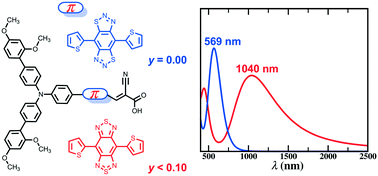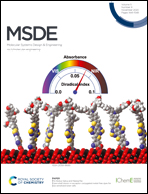Open-shell donor–π–acceptor conjugated metal-free dyes for dye-sensitized solar cells†
Abstract
Dye-sensitized solar cells (DSCs) have drawn a significant interest due to their low production cost, design flexibility, and the tunability of the sensitizer. However, the power conversion efficiency (PCE) of the metal-free organic dyes is limited due to the inability of the dye to absorb light in the near-infrared (NIR) region, leaving a large amount of energy unused. Herein, we have designed new DSC dyes with open-shell character, which significantly red-shifts the absorption spectra from their counterpart closed-shell structure. A small diradical character (y < 0.10) is found to be beneficial in red-shifting the absorption maxima into the NIR region and broadening up to 2500 nm. Also, the open-shell dyes significantly reduce the singlet–triplet energy gaps (ΔEST), increase the total amount of charge-transfer to the semiconductor surface, reduce the exciton binding energy, and significantly increase the excited-state lifetimes compared to the closed-shell systems. However, the closed-shell dyes have higher injection efficiency with increased intramolecular charge transfer (ICT) character. Our study reveals the design rule for open-shell DSC dyes to be able to absorb photons in the NIR region, which can increase the efficiency of the solar cell device.



 Please wait while we load your content...
Please wait while we load your content...